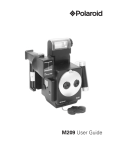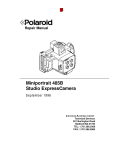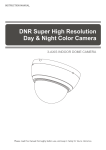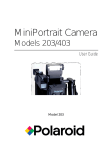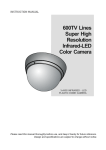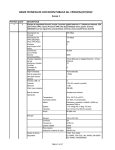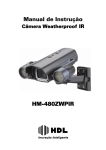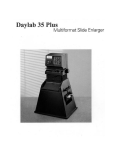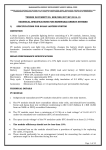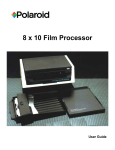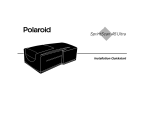Download 545 Pro Film Holder User Guide
Transcript
545 Pro Film Holder User Guide Contents 1 Introduction 2 Film Holder 3 Film Codes 4 Attaching the holder to the camera 5 Determining the processing time 6 Displaying the ambient temperature 7 Displaying the exposure compensation value 8 Displaying the film processing time 9 Changing the auto off option 10 11 12 13 14 15 16 17 18 19 19 LCD display Loading the film Making the exposure Processing more than one film Timing more than one film Removing film for later processing. Changing the batteries Cleaning the rollers Troubleshooting Warranty Caution English 1 Introduction Thank you for choosing the Polaroid 545 Pro Film Holder. This enables you to use Polaroid 4x5 sheet films in most 4x5 field or view cameras that are equipped with spring backs, lock backs and similar backs, without making any alteration to the camera or focusing system. It comes equipped with a built in film processing timer which provides visible and audible indication of processing time for a variety of Polaroid film types and can display any required exposure compensation for the Polaroid film type used. The film holder can also be used with instruments (such as microscope and oscilloscope cameras) equipped with similar backs, and with the Polaroid MP-4+ and MP-4 cameras, the CU-5 4x5 camera (88-45) and Polaroid Miniportrait 4x5 cameras. Important: When the holder is not in use, leave the control arm at P (as shown in illustration 1.) The numbers throughout the text refer to the illustrations at the end of the book. 3 2 a b c d e f g h i j k l m n o p q r s Film holder (Illustration 1) Focal plane Steel processing rollers Rubber light seal roller Hinged roller cover Roller hooks Film slot Film processing timer Control arm Film release lever Timer code table LCD backlight button Scroll button Mode button Film timer code icon Ambient temperature icon Exposure compensation icon Processing time icon Film engaged icon Auto off function icon 3 Film timer codes The actual image area of Polaroid 4x5 Instant Sheet films is approx. 3 1/2 x 41/2 in. (9 x 11.5cm), and is off centre about 1/8 in. (3mm) toward the thicker end of the holder. This area is marked on the ground glasses for the MP 4+ and MP-4 cameras, but may not correspond precisely with the area marked on the other ground glasses. For extreme accuracy in composition, make test shots and mark the exact area on your ground 4 English FILM TYPE DESCRIPTION Polapan 51 HC High contrast, black and white film producing 80 both a negative and positive print. Polacolor 52 Black and white, coaterless, medium contrast film for general photographic purposes. 03 Polapan 53 High quality, high speed, medium contrast, panchromatic black and white film. 73 Polapan 54 Black and white, medium contrast, coated film for professional photographic proofing. 73 Polapan 55 PN Panchromatic black and white film that produces 90 both a positive print and a recoverable negative. Polapan 56 Sepia A medium contrast sepia tone film for creative 63 professional photography. Polapan 57 Panchromatic black and white, high speed, 03 medium contrast coated film. Polacolor 59 Polacolor ER (Extended Range) colour print film, balanced for daylight and electronic flash (5500oK). 42 Polacolor 64 Tungsten Colour print film balanced for longer exposure times with tungsten/halogen light source (3200oK). 25 Polapan 72 High quality, medium contrast black and white 54 film for professional and scientific purposes. Colour print film, balanced for daylight and Polacolor Pro100 electronic flash (5500oK) for professional (Type 79) photographic proofing. 10 The Polaroid Corporation reserves the right to change the film timer codes without any prior warning. If in any doubt, contact the customer services department for the latest information. English 4 5 a Attaching the holder to the camera Before use, open the roller cover and inspect the processing rollers. Clean them if necessary (see section 16 Cleaning the rollers). Slide the holder into the back of the camera, just as you would a standard film holder. If your camera has slide locks, use them in addition to the spring back; the locks fit into slots on the sides of the film holder. Determining the processing time The processing time for any exposure is dependent on the film type. Each Polaroid film type has a two digit timer code which can be found on the film packaging, on the film holder or in the table on the previous page. This timer code has to be entered manually into the timer: Press the mode button until the film timer code icon is displayed. c Pushing the scroll button again will rotate the numbers from 0 to 9. d When you have reached the desired number press the mode button and the right digit will flash. Repeat step c. Once the correct film timer code is displayed, press the mode button to save the selection. e 6 a b b Pressing the scroll button will cause the left digit to flash. 5 Displaying the ambient temperature Press the mode button until the temperature icon is displayed. Pressing the scroll button changes the display from °C to °F. 6 English Caution: The timer will function only within the temperature range -10°C 35°C (14°F-95°F). If outside this range, the timer will show a warning signal in which the LCD display will alternate between showing the peel time and a “HI” or “LO” signal. This indicates that the film is being used outwith the recommended temperature guidelines and therefore in these extreme conditions the indicated peel timer may be inaccurate. 7 a Displaying the exposure compensation value To obtain the best results from some Polaroid films, the camera exposure must be altered by a value dependent on temperature and film type. Press the mode button until the exposure compensation 8 a automatically and the time counts down to zero. 9 a b b icon is displayed. Adjust the camera by the number of stops shown. Displaying the film processing time Press the mode button until the processing time icon is displayed. Film processing time is dependent on film type (film timer code) and ambient temperature. When the film is removed from the film holder, this mode is selected Changing the auto off options mode This function allows you to manually turn off the timer and / or alter the period after which the timer automatically powers down if no user intervention. Press the mode button until the auto off options icon is displayed. Pressing the scroll button will cause the OFF display to flash. English c If you wish to manually switch off the timer, press the mode button at this point and the display will power down. Alternatively, to change the time out period, press the scroll button to toggle through the auto off settings. The timer can be set to power down after 1, 5, 15, 30 minutes or 1 hour. if no user intervention occurs d Press the mode button to save the auto off time. 10 LCD Backlight The timer comes with an LCD backlight to operate this press and hold the blue button (1k) below the display. When the button is not depressed the backlight will go off. 7 11 Loading the film a Move the control arm to L (2). b Hold the envelope as shown (3) and insert the metal clip end into the holder. Be sure that the side marked THIS SIDE TOWARD LENS faces the lens. Do not hold the envelope by the end when first inserting it into the holder, as you may buckle the envelope (4) and damage the film. Do not press on the area marked DO NOT PRESS HERE where the pod of developer chemicals is located. c Push the envelope in halfway (5), then shift your grip to the end, and push it in the rest of the way (6). When the envelope is fully inserted the timer will display a film engaged symbol in the top right corner. If this is not displayed, the film is not engaged correctly. Remove the film from the holder and repeat the process. Note that if film is loaded and no user intervention of the timer occurs for more than 4 hours, the engaged symbol will disappear from the display. 8 English 12 Making the exposure a Gently withdraw the envelope from the holder until it comes to a firm stop (7). It will come out almost 6 inches (15cm), then stop. The negative will remain inside the holder, ready for exposure. To prevent possible light leak, the envelope should not be removed for longer than necessary. If outdoors, protect the envelope from bright sunlight and also from bending in the wind. b If you wish to use the timer in the processing of the film, check the timer display is powered up (press any button) and ensure the film engaged symbol is still displayed. If this symbol is not displayed, the negative was withdrawn accidently with the envelope. Push the envelope in again, withdraw it, and check again. c Make the exposure.The recommended exposure meter setting is printed on the film envelope. d Push the envelope all the way in (8). Use moderate pressure but don’t force it. If the envelope will not slide in all the way, withdraw it slightly and try again. The exposed film is now ready to be processed. 13 Processing the film a Move the control arm to P (9). b Grip the envelope firmly, and pull it straight, all the way out of the holder (10). Pull smoothly, at medium speed, without slowing down or stopping. You will feel a slight resistance when the metal cap reaches the rollers, but continue pulling without hesitation. The rollers will separate to allow the cap to pass through. c On pulling the film through the rollers the peel timer will automatically count down the processing time. At the end of this time a single beep will sound to indicate the processing time is complete. d Remove the print from the envelope: grip both tabs with your thumbs as shown (11). Roll both flaps back slightly. Using moderate pressure, tear the envelope open all the way down to the metal cap (12). With your left thumb hold down the negative and thin paper mask, and with your right hand quickly lift off the print (13). It will come right out of the envelope. With the exception of English Type55P/N film, the negative serves no further purpose. Discard it with the envelope. Avoid contact with the chemical on the negative. This process uses a caustic paste. Avoid contact with skin, eyes and mouth and keep away from children and animals. If you get paste on your skin, wipe it off immediately and wash with water to avoid an alkali burn. If eye or mouth contact occurs, quickly wash the area with plenty of water and see a doctor. Keep discarded materials away from children, animals, clothing and furniture. Type 55P/N film only: Use your left thumb to hold down the negative. With your right hand, quickly peel away the print and thin paper mask. Pull hard, and the print and mask will separate completely from the negative section and cap. Remove the mask from the print and discard the mask. Complete instructions on removing the negative from the envelope and preparing it for enlargement are in the film instructions. 9 14 Timing more than one film The film processing timer has the ability to time up to three Polaroid Instant films simultaneously. The display indicates the timer countdown of the first processed film by displaying the digit 1 to the right of the time display. On completion of this development the timer sounds a single beep and displays the second film’s remaining process time. The timers sounds a double beep on completion of the second film’s process time and so on until all film process times are complete. 15 Removing film for later processing a After exposure, re-insert the envelope; push it in very firmly to ensure that it engages the metal cap at the end of the negative. Do not move the control arm to P. Leave it at L. b Remove the film holder from the camera. Depress the film 10 c English release lever R (14). Keepthe lever depressed throughout the following procedure. Hold the film holder in one hand with the opening in the film plane facing you. With the thumb of the other hand, gently push the film envelope out as shown (15) until the metal cap is visible. Then grasp the end of the envelope and pull it out. To process the film, carefully reinsert the envelope into the film holder as when first loading, move the control arm to P, and process it as described in section 12. 16 Changing the batteries If the display or tone fades, or if the timer stops functioning, the batteries should be replaced. The timer uses either two 1.5 volt SR-54 or two 1.5 volt LR-54 batteries. Slide battery cover open (16) and the insert batteries (17). Then replace the cover. The timer will display “545” for a few seconds as shown. Always re-enter the film timer code and reset the Auto off function after changing the batteries. NOTE: It is recommended that the SR-54 batteries are used as LR-54 batteries will require to be replaced more often. 17 Cleaning the rollers Dirt on the two steel processing rollers can cause repeated spots on the print and poor colours. Check regularly to see that the rollers are clean and free of foreign matter. a Move the control arm to L (?). b Grip the hinged roller cover as shown (18) and pull upward to open the cover. c Disengage the hooks (19) at the ends of the rollers. The top roller will swing up to permit easy cleaning of the entire assembly (20). d Clean the rollers with a soft, lint free cloth, dampened with water if necessary. Rotate the rollers as you clean and inspect them. Also clean therubber light seal roller. Never scrape the rollers with anything metallic, nor with your fingernail. e Replace the top roller, engage the hooks, then snap the cover closed. English 18 Troubleshooting No exposure: A completely black picture indicates that no light reached the negative. Check that your equipment is functioning (shutter, flash sync, etc.) This also can be caused by failure to insert the film envelope all the way into the the holder when loading the film; failure to withdraw the envelope before exposing the film; or failure of the holder to catch the metal cap when the envelope was inserted. Check the film loading instructions. If this trouble occurs frequently, check the film holder for possible malfunction. Black edge: Failure to withdraw the protective envelope fully before making an exposure will produce a black strip along the edge of the picture. Always withdraw the envelope as far as possible before exposing the film. Missing corners: With black and white film, this can be caused by pulling too fast; with colour film it can be caused by pulling either too fast or too slowly. Pull straight, at medium speed, without hesitation. 11 Spots: Deposits of dirt or foreign matter on the steel rollers will cause evenly spaced spots or marks across the length of the picture. Inspect and clean the rollers regularly. Streaks: If your pulling motion is uneven or jerky when removing the film envelope, the rollers will leave impressions across the picture in the form of vertical streaks. Always pull smoothly without hesitation. Detached envelope: If the film is loaded backwards, the envelope will detach completely when withdrawn for exposure. To gain access to the negative (which remains inside the holder), open the hinged cover and disengage the rollers just as you would for cleaning. Move the control arm to P (9) and withdraw the negative by pulling the negative tab. 12 a b c d e English Jammed metal cap: If the negative (and metal clip) cannot be removed from the holder as described above, you can disassemble the holder as follows: Move the control arm to L(?). Insert a small flat-head screwdriver into the slot below the side clip, and twist it to pry off the clip (21). Remove both side clips. Tilt the back panel up, then remove it from the film holder (22). Remove the jammed cap and negative. To replace the back panel, insert the end of the panel under the lip of the roller cover (23), then lower the panel into position. Hold the back panel in position, and replace the side clips. Metal cap and envelope misaligned: If mishandled, the envelope and the metal clip may become misaligned (24). If the metal clip and tape on the back of the envelope are not parallel, tap the length of the cap lightly against a flat, solid surface. 19 Warranty Your Polaroid 545 Pro Film Holder has been thoroughly tested and inspected before shipment. All parts are guaranteed against defects in materials and workmanship for one full year from the date of original purchase. During this period, any such defects will be remedied by Polaroid Corporation without charge, except for transportation costs. Damage resulting from normal wear, mishandling or accident will be promptly repaired at a reasonable charge. To make returns pack the holder carefully in it’s original shipping carton or other sturdy container with plenty of padding and ship it prepaid to your nearest Polaroid Office (see list on back page). a b c 1 d n o p q r s e g f l m k h i j 2 3 4 5 6 7 8 9 10 11 12 13 14 15 16 17 18 19 20 21 22 23 24

















